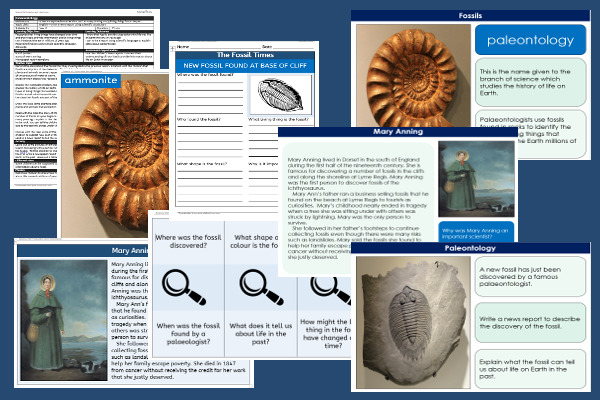Lesson Two – Paleontology

This science teaching pack for Key Stage Two gets the children to explore and record how scientists such as Mary Anning observed, studied and presented information about a range of different living things from the past.
The class can practise composing a newspaper report to record and publish information and facts about the discovery of a fossil to explain how life was different in the past.
Download this teaching pack including a lesson plan, classroom activities and an interactive presentation to explore and record how scientists such as Mary Anning observed, studied and presented information about a range of different living things from the past
Activities in this teaching pack include display posters to identify and describe living things as shown in a range of different fossils, a shared reading text to describe the life and work of a famous paleontologist who researched fossils, a table display card to collect and record information about a fossil to use in a newspaper report and a template to record answers to key questions as part of a newspaper report about a fossil discovery.
The interactive presentation can be used to explore how scientists such as Mary Anning observed and studied a range of different living things from the past.
This lesson is part of a science scheme of work to get the children to explore how living things adapt and evolve over time as a result of competition for natural resources and transfer inherited traits to their offspring. There are teaching activities for shared learning, differentiated worksheets to support independent learning and interactive presentations to introduce concepts and key skills.
-

Determinant Lists
Explain and model how to make lists of objects used and found in different locations to match the correct determinants of a and an
-

English SPAG Assessment
Assess abilities in composing sentences for fiction and non-fiction using the correct spellings, punctuation marks and grammar vocabulary phrases
-

Maths Arithmetic Assessment
Assess abilities in solving arithmetic number problems for addition, subtraction, multiplication and division when working with informal and formal written calculations
-

Environment
Identify and describe some of the special landscapes and locations that can be found in the world and reflect on how they can be protected and preserved for the future
